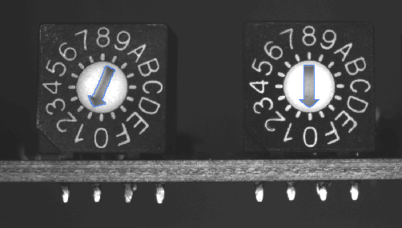匹配技术用于以亚像素精度定位图像中的轮廓或纹理,即使这些轮廓或纹理被旋转或部分覆盖。具体做法是在参考图像中创建一个模板,并推导出一个用于教导的模型。然后利用该模型在图像采集中搜索匹配的图像。
视觉功能匹配可使用以下匹配方法之一进行:
•基于相关性的匹配:
•基于相关性的匹配基于灰度值。归一化交叉相关(NCC)用于评定模型与搜索图像的匹配程度。这种方法可以对加法和乘法照明偏差进行补偿。
与基于形状的匹配法相比,这种方法可以找到形状略有不同或表面纹理丰富的物体,也可以找到模糊图像中的物体。
•基于形状的匹配
•基于形状的匹配不使用灰度值,而是定义轮廓的形状。
•基于形状的匹配能快速、准确、稳健地找到物体。即使物体被旋转、缩放、视角扭曲、局部变形、部分遮挡、超出图像或受到非线性光照波动的影响,它也能正常工作。
有关匹配器使用的寄存器概览,请参阅寄存器概览章节。 .
信息:
有关视觉功能的使用案例,请参阅匹配教学和后续对象搜索 - 。
有关视觉功能的常见问题,请参阅匹配常见问题.。 .
本节主题:
Matching is used to locate contours or textures in images with subpixel accuracy, even if they are rotated or partially covered. This is done by creating a template in a reference image and deriving a model to be used for teach-in. The model is then used to search for matches in image acquisitions.
Vision function Matching can be performed using one of the following Matching methods:
•Correlation-based Matching:
•Correlation-based Matching is based on grayscale values. Normalized cross-correlation (NCC) is used to grade how well the model matches the image being searched. The method can compensate for both additive and multiplicative lighting deviations.
•In contrast to shape-based Matching, is it possible to find objects with slightly different shapes or highly textured surfaces, as well as objects in blurred images.
•Shape-based Matching:
•Shape-based Matching does not use grayscale values; it defines the shape of the contours instead.
•Shape-based Matching finds objects quickly, accurately and robustly. It even works if they are rotated, scaled, perspectively distorted, locally deformed, partially covered, outside of the image or subject to nonlinear illumination fluctuations.
For an overview of the registers used by Matching, see section Overview of registers.
Information:
For vision function use cases, see Matching - Teach-in and subsequent object search.
For FAQ about the vision function, see Matching FAQ.
